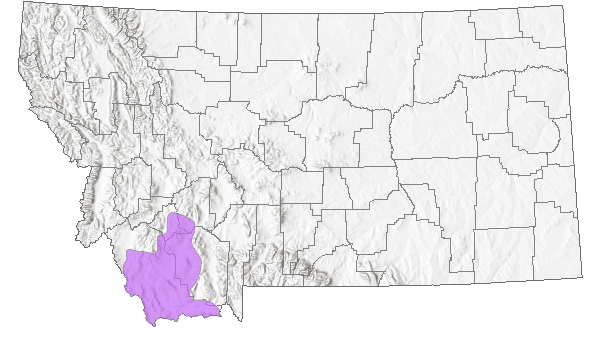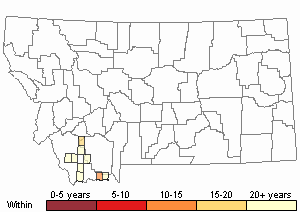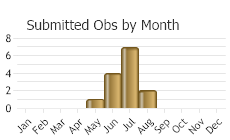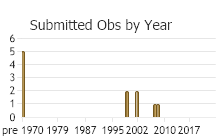View in other NatureServe Network Field Guides
NatureServe
Montana
Utah
Wyoming
Idaho
Wisconsin
British Columbia
South Carolina
Yukon
California
New York
Columbia Plateau Pocket Mouse - Perognathus parvus
General Description
The Columbia Plateau Pocket Mouse is the largest member of the genus Perognathus. Tail length is 110 to 120% of head and body length, and distinctly bicolored. The hind legs are elongated, but not to the extent observed in bipedal heteromyids such as kangaroo rats. They have external, fur-lined cheek pouches, hence the name pocket mouse. The dorsal pelage is pinkish-buff or ocherous-buff overlain with black hairs; the belly is white to buffy. Adults from Oregon attain the following body measurements: total length 138 to 205 millimeters; tail length 53 to 115 millimeters; hind foot 19 to 27 millimeters; and weight 9.5 to 29.5 grams (Verts and Carraway 1998). On the skull, the auditory bullae are not greatly inflated but meet or nearly meet anteriorly, the upper incisors are grooved, the nasal septum is perforated (connecting right and left infraorbital canals), and the molars are hypsodont (high-crowned and fully covered in enamel). There are 20 teeth in the skull (dental formula: I 1/1, C 0/0, P 1/1, M 3/3).
Diagnostic Characteristics
The combination of grooved incisors, hypsodont molars, perforate nasal septum, fur-lined external cheek pouches, and very long tail distinguish the Columbia Plateau Pocket Mouse from other non-heteromyid rodents. For other heteromyid species in Montana, Ord's Kangaroo Rat (Dipodomys ordii) differs by having greatly elongated hind legs, a hind foot length more than 30 millimeters, and the mastoid (rear) region of the skull greatly expanded. The Hispid Pocket Mouse (Chaetodipus hispidus) has mastoids that do not project beyond the occipital plane, auditory bullae that are clearly separated, rough pelage, and naked soles on the hind feet. The Olive-backed Pocket Mouse (Perognathus fasciatus) has an unlobed antitragus (fleshy projection) in the ear, an occipitonasal length (anterior tip of nasal bone to posterior tip of occipital bone at base of skull) less than 24 millimeters, a uniformly-colored tail, and a hind foot length less than 20 millimeters. The range of the Great Basin Pocket Mouse does not overlap in Montana with the above species (Foresman 2012, 2001).
Species Range
Montana Range
Range Descriptions

 Native
Native
Observations in Montana Natural Heritage Program Database
Number of Observations: 14
(Click on the following maps and charts to see full sized version)
Map Help and Descriptions
Relative Density

Recency



 (Observations spanning multiple months or years are excluded from time charts)
(Observations spanning multiple months or years are excluded from time charts)
Migration
The Columbia Plateau Pocket Mouse is non-migratory. Little other information exists for Montana. Home ranges in British Columbia, Washington, and Oregon are 267 to 4005 square meters, and vary with year, sex, age, population density, and resource availability. The distances home range centers shift between successive years are 2 to 43 meters for males and 1 to 10 meters for females; all evidence indicates the species is relatively sedentary (Verts and Kirkland 1988).
Habitat
Occupied habitats in Montana are arid and sometimes sparsely vegetated. They include grassland-shrubland with less than 40% cover, stabilized sandhills, and landscapes with sandy soils, more than 28% sagebrush cover, and 0.3 to 2.0 meters shrub height (Hoffmann et al. 1969, Frissell 1978, Hendricks and Roedel 2001, 2002).
Data from other portions of its range suggest a variety of western arid and semiarid habitats are occupied, including pine woodland, juniper-sagebrush scablands, sandy short-grass steppes, and shrubland covered with sagebrush, bitterbrush, greasewood, and rabbitbrush; heavily forested habitats are avoided. They are captured more often than expected (based on availability) at sites with more than 40% ground cover. On plots where fire killed the shrub cover, the species was one-third as abundant as on adjacent unburned plots. They usually are found in habitats with light-textured, deep soils, and sometimes in shrublands among rocks. Presence is positively correlated with percent sand and negatively with percent clay. Adults sleep and rear young in underground burrows (Verts and Kirkland 1988, Verts and Carraway 1998).
Ecological Systems Associated with this Species
- Details on Creation and Suggested Uses and Limitations
How Associations Were Made
We associated the use and habitat quality (common or occasional) of each of the 82 ecological systems mapped in Montana for
vertebrate animal species that regularly breed, overwinter, or migrate through the state by:
- Using personal observations and reviewing literature that summarize the breeding, overwintering, or migratory habitat requirements of each species (Dobkin 1992, Hart et al. 1998, Hutto and Young 1999, Maxell 2000, Foresman 2012, Adams 2003, and Werner et al. 2004);
- Evaluating structural characteristics and distribution of each ecological system relative to the species' range and habitat requirements;
- Examining the observation records for each species in the state-wide point observation database associated with each ecological system;
- Calculating the percentage of observations associated with each ecological system relative to the percent of Montana covered by each ecological system to get a measure of "observations versus availability of habitat".
Species that breed in Montana were only evaluated for breeding habitat use, species that only overwinter in Montana were only evaluated for overwintering habitat use, and species that only migrate through Montana were only evaluated for migratory habitat use.
In general, species were listed as associated with an ecological system if structural characteristics of used habitat documented in the literature were present in the ecological system or large numbers of point observations were associated with the ecological system.
However, species were not listed as associated with an ecological system if there was no support in the literature for use of structural characteristics in an ecological system,
even if point observations were associated with that system.
Common versus occasional association with an ecological system was assigned based on the degree to which the structural characteristics of an ecological system matched the preferred structural habitat characteristics for each species as represented in scientific literature.
The percentage of observations associated with each ecological system relative to the percent of Montana covered by each ecological system was also used to guide assignment of common versus occasional association.
If you have any questions or comments on species associations with ecological systems, please contact the Montana Natural Heritage Program's Senior Zoologist.
Suggested Uses and Limitations
Species associations with ecological systems should be used to generate potential lists of species that may occupy broader landscapes for the purposes of landscape-level planning.
These potential lists of species should not be used in place of documented occurrences of species (this information can be requested at:
mtnhp.org/requests) or systematic surveys for species and evaluations of habitat at a local site level by trained biologists.
Users of this information should be aware that the land cover data used to generate species associations is based on imagery from the late 1990s and early 2000s and was only intended to be used at broader landscape scales.
Land cover mapping accuracy is particularly problematic when the systems occur as small patches or where the land cover types have been altered over the past decade.
Thus, particular caution should be used when using the associations in assessments of smaller areas (e.g., evaluations of public land survey sections).
Finally, although a species may be associated with a particular ecological system within its known geographic range, portions of that ecological system may occur outside of the species' known geographic range.
Literature Cited
- Adams, R.A. 2003. Bats of the Rocky Mountain West; natural history, ecology, and conservation. Boulder, CO: University Press of Colorado. 289 p.
- Dobkin, D. S. 1992. Neotropical migrant land birds in the Northern Rockies and Great Plains. USDA Forest Service, Northern Region. Publication No. R1-93-34. Missoula, MT.
- Foresman, K.R. 2012. Mammals of Montana. Second edition. Mountain Press Publishing, Missoula, Montana. 429 pp.
- Hart, M.M., W.A. Williams, P.C. Thornton, K.P. McLaughlin, C.M. Tobalske, B.A. Maxell, D.P. Hendricks, C.R. Peterson, and R.L. Redmond. 1998. Montana atlas of terrestrial vertebrates. Montana Cooperative Wildlife Research Unit, University of Montana, Missoula, MT. 1302 p.
- Hutto, R.L. and J.S. Young. 1999. Habitat relationships of landbirds in the Northern Region, USDA Forest Service, Rocky Mountain Research Station RMRS-GTR-32. 72 p.
- Maxell, B.A. 2000. Management of Montana's amphibians: a review of factors that may present a risk to population viability and accounts on the identification, distribution, taxonomy, habitat use, natural history, and the status and conservation of individual species. Report to U.S. Forest Service Region 1. Missoula, MT: Wildlife Biology Program, University of Montana. 161 p.
- Werner, J.K., B.A. Maxell, P. Hendricks, and D. Flath. 2004. Amphibians and reptiles of Montana. Missoula, MT: Mountain Press Publishing Company. 262 p.
- Commonly Associated with these Ecological Systems
Shrubland, Steppe and Savanna Systems
Sparse and Barren Systems
- Occasionally Associated with these Ecological Systems
Grassland Systems
Shrubland, Steppe and Savanna Systems
Wetland and Riparian Systems
Food Habits
Food habits of Columbia Plateau Pocket Mouse have not been studied in Montana. Information from other areas of the species' range indicate that this species is primarily a seedeater of grasses, legumes, borages, composites, nettles, and mustards, and in spring also feeds on insects (20 to 25% of diet and contents in cheek pouches) and some green vegetation. Seeds are carried back to burrows in cheek pouches and stored in underground chambers (Verts and Kirkland 1988, Verts and Carraway 1998). They sometimes forage in grain fields but significant damage has not been noted, although they may consume newly planted or sprouted seed, and may cache seeds of one type of grain in a field sown with a different type. Their diet in Montana has not been studied or reported.
Ecology
Very little is known about this pocket mouse in Montana. Information from other parts of its range suggests the Columbia Plateau Pocket Mouse is not considered a social animal; individuals occupy separate nests. During winter it enters torpor and is not surface-active, but it may also enter torpor for various periods at any season. Male emergence from winter torpor is in late March or April, depending on location, and females emerge about a month later (Verts and Kirkland 1988). All Montana captures have occurred between mid-June and mid-August (Hoffmann et al. 1969, Frissell 1978, Hendricks and Roedel 2002). It is nocturnal or crepuscular when active away from its burrow.
Frequently it is the most abundant small mammal in the Great Basin, especially in the northern portion of its range where it may represent up to 90% of the small mammals captured. At the community level it is the prime energy mover, and contributes 4 times more to energy exchange than the Deer Mouse and 11 times that of the Northern Grasshopper Mouse. Population density may reach 80+ per hectare in years with abundant precipitation, and density is positively correlated with October to April precipitation. Predators include rattlesnakes, Burrowing and Short-eared Owls, Coyotes, weasels, skunks, Badgers, foxes, Northern Grasshopper Mice, and Deer Mice (Verts and Kirkland 1988, Verts and Carraway 1998).
Reproductive Characteristics
No information on the reproductive biology of the Columbia Plateau Pocket Mouse for Montana is available. Information from other parts of its range suggests Great Basin Pocket Mice are reproductively active during spring and summer. Estrous in Washington is during April and May. Pregnant females in Idaho are present from late May to early August. Gestation probably lasts about 21 to 28 days, with females producing 0 to 3 litters per year, depending on winter-spring precipitation. The number of fetuses per female ranges from 2 to 8 (average about 5). Lactation may extend into September or sometimes October. Young are weaned in about 3 weeks (Verts and Kirkland 1988, Verts and Carraway 1998).
Management
No special management activities are currently recognized as necessary for maintaining viable populations of this species in Montana. Land management designed to maintain a mosaic of sagebrush cover, size, and age classes will benefit this species, especially if it promotes the growth of grasses and forbs within sagebrush stands; large-scale sagebrush removal should be avoided. Livestock probably competes with Great Basin Pocket Mice for grasses and reduce shrub and grass cover (Hendricks and Roedel 2001).
Stewardship Responsibility
References
- Literature Cited AboveLegend:
 View Online Publication
View Online Publication Foresman, K. R. 2001. Key to the mammals of Montana. University of Montana Bookstore, Missoula, Montana. 92 pp.
Foresman, K. R. 2001. Key to the mammals of Montana. University of Montana Bookstore, Missoula, Montana. 92 pp. Foresman, K.R. 2012. Mammals of Montana. Second edition. Mountain Press Publishing, Missoula, Montana. 429 pp.
Foresman, K.R. 2012. Mammals of Montana. Second edition. Mountain Press Publishing, Missoula, Montana. 429 pp. Frissell, S. S. 1978. Non-game wildlife inventory. Prepared for: US Department of the Interior, Bureau of Land Management, Dillon Resource Area, Dillon, Montana. 194 pp.
Frissell, S. S. 1978. Non-game wildlife inventory. Prepared for: US Department of the Interior, Bureau of Land Management, Dillon Resource Area, Dillon, Montana. 194 pp. Hendricks, P. and M. Roedel. 2001. A faunal survey of the Centennial Valley Sandhills, Beaverhead County, Montana. Report to the U.S. Bureau of Land Management and U.S. Fish and Wildlife Service. Montana Natural Heritage Program, Helena, MT. 44 p.
Hendricks, P. and M. Roedel. 2001. A faunal survey of the Centennial Valley Sandhills, Beaverhead County, Montana. Report to the U.S. Bureau of Land Management and U.S. Fish and Wildlife Service. Montana Natural Heritage Program, Helena, MT. 44 p. Hendricks, P. and M. Roedel. 2002. Preble's shrew and Great Basin pocket mouse from the Centennial Valley Sandhills of Montana. Northwestern Naturalist 83:31-34.
Hendricks, P. and M. Roedel. 2002. Preble's shrew and Great Basin pocket mouse from the Centennial Valley Sandhills of Montana. Northwestern Naturalist 83:31-34. Riddle, Brett R.; Jezkova, Tereza; Eckstut, Mallory E.; Olah-Hemmings, Viktoria; Carraway, Leslie N. 2014. Cryptic divergence and revised species taxonomy within the Great Basin Pocket Mouse, Perognathus parvus (Peale, 1848), species group. Journal of Mammalogy. V.95 No. 1 Pg 9-25.
Riddle, Brett R.; Jezkova, Tereza; Eckstut, Mallory E.; Olah-Hemmings, Viktoria; Carraway, Leslie N. 2014. Cryptic divergence and revised species taxonomy within the Great Basin Pocket Mouse, Perognathus parvus (Peale, 1848), species group. Journal of Mammalogy. V.95 No. 1 Pg 9-25. Verts, B. J. and L. N. Carraway. 1998. Land mammals of Oregon. University of California Press, Berkeley. xvi + 668 pp.
Verts, B. J. and L. N. Carraway. 1998. Land mammals of Oregon. University of California Press, Berkeley. xvi + 668 pp. Verts, B.J. and G.L. Kirkland, Jr. 1988. Perognathus parvus. Mammalian Species 318:1-8.
Verts, B.J. and G.L. Kirkland, Jr. 1988. Perognathus parvus. Mammalian Species 318:1-8.
- Additional ReferencesLegend:
 View Online Publication
View Online Publication
Do you know of a citation we're missing? Elliott, Joe C. and Hydrometrics, Inc., Helena, MT., 1994, Supplement to wildlife baseline investigation life-of-mine expansion plan: Regal Mine, Barretts Minerals, Inc., Madison County, Montana. August 2000. In Life-of Mine Expansion Plan: Barretts Minerals, Inc., Regal Mine, Madison County, Montana. Vol. 2. App. C: Baseline Wildlife Reconnaissance. December 1999.
Elliott, Joe C. and Hydrometrics, Inc., Helena, MT., 1994, Supplement to wildlife baseline investigation life-of-mine expansion plan: Regal Mine, Barretts Minerals, Inc., Madison County, Montana. August 2000. In Life-of Mine Expansion Plan: Barretts Minerals, Inc., Regal Mine, Madison County, Montana. Vol. 2. App. C: Baseline Wildlife Reconnaissance. December 1999. Feldhamer, G.A. 1979. Vegetative and edaphic features affecting the abundance and distribution of small mammals in southeast Oregon. Great Basin Nat. 39:207-218.
Feldhamer, G.A. 1979. Vegetative and edaphic features affecting the abundance and distribution of small mammals in southeast Oregon. Great Basin Nat. 39:207-218. Flath, D. L. 1984. Vertebrate species of special interest or concern. Mammals, birds, reptiles, amphibians, fishes. Spec. Publ. Montana Department of Fish, Wildlife, and Parks, Helena. 76 pp.
Flath, D. L. 1984. Vertebrate species of special interest or concern. Mammals, birds, reptiles, amphibians, fishes. Spec. Publ. Montana Department of Fish, Wildlife, and Parks, Helena. 76 pp. Flath, D.L. 1979. Nongame species of special interest or concern: Mammals, birds, reptiles, amphibians, fishes. Wildlife Division, Montana Department of Fish and Game. Helena, MT.
Flath, D.L. 1979. Nongame species of special interest or concern: Mammals, birds, reptiles, amphibians, fishes. Wildlife Division, Montana Department of Fish and Game. Helena, MT. Foresman, K.R. 2001. The wild mammals of Montana. American Society of Mammalogists, Special Publication Number 12. Lawrence, KS. 278 pp.
Foresman, K.R. 2001. The wild mammals of Montana. American Society of Mammalogists, Special Publication Number 12. Lawrence, KS. 278 pp. Hall, E.R. 1981. The mammals of North America, volumes I and II. John Wiley & Sons, New York, NY. 1181 pp.
Hall, E.R. 1981. The mammals of North America, volumes I and II. John Wiley & Sons, New York, NY. 1181 pp. Hayward, C.L. and M.L. Killpack. 1958. Distribution and variation of the Utah population of the great basin pocket mouse. Great Basin Nat. 18:26.
Hayward, C.L. and M.L. Killpack. 1958. Distribution and variation of the Utah population of the great basin pocket mouse. Great Basin Nat. 18:26. Hoffmann, R.S. and D.L. Pattie. 1968. A guide to Montana mammals: identification, habitat, distribution, and abundance. Missoula, MT: University of Montana. 133 p.
Hoffmann, R.S. and D.L. Pattie. 1968. A guide to Montana mammals: identification, habitat, distribution, and abundance. Missoula, MT: University of Montana. 133 p. Hoffmann, R.S., P.L. Wright, and F.E. Newby. 1969. The distribution of some mammals in Montana. I. Mammals other than bats. Journal of Mammalogy 50(3): 579-604.
Hoffmann, R.S., P.L. Wright, and F.E. Newby. 1969. The distribution of some mammals in Montana. I. Mammals other than bats. Journal of Mammalogy 50(3): 579-604. Joslin, Gayle, and Heidi B. Youmans. 1999. Effects of recreation on Rocky Mountain wildlife: a review for Montana. [Montana]: Montana Chapter of the Wildlife Society.
Joslin, Gayle, and Heidi B. Youmans. 1999. Effects of recreation on Rocky Mountain wildlife: a review for Montana. [Montana]: Montana Chapter of the Wildlife Society. Kritzman, E.B. 1973. Ecological relationships of Peromyscus maniculatus & Perognathus parvus in Eastern WA. 1974. J. Mammal. 55:172-188.
Kritzman, E.B. 1973. Ecological relationships of Peromyscus maniculatus & Perognathus parvus in Eastern WA. 1974. J. Mammal. 55:172-188. Medin, D. E. and W. P. Clary. 1991. Small mammals of a beaver pond ecosystem and adjacent riparian habitat in Idaho. USDA, Forest Service, Res. Paper INT-445.
Medin, D. E. and W. P. Clary. 1991. Small mammals of a beaver pond ecosystem and adjacent riparian habitat in Idaho. USDA, Forest Service, Res. Paper INT-445. O'Farrell, T. P., R. J. Olson, R. O. Gilbert, and J. D. Hedlund. 1975. A population of Great Basin pocket mice (Perognathus parvus) in the shrub-steppe of south-central Washington. Ecol. Monogr. 45(1):1-28.
O'Farrell, T. P., R. J. Olson, R. O. Gilbert, and J. D. Hedlund. 1975. A population of Great Basin pocket mice (Perognathus parvus) in the shrub-steppe of south-central Washington. Ecol. Monogr. 45(1):1-28. Reid, F. 2006. Peterson Field Guide to Mammals of North America, 4th Edition. Houghton Mifflin Company: Boston and New York, 608 pp.
Reid, F. 2006. Peterson Field Guide to Mammals of North America, 4th Edition. Houghton Mifflin Company: Boston and New York, 608 pp. Rust, H. J. 1946. Mammals of northern Idaho. J. Mammal. 27(4): 308-327.
Rust, H. J. 1946. Mammals of northern Idaho. J. Mammal. 27(4): 308-327. Schladweiler, Philip, and John P. Weigand., 1983, Relationships of endrin and other chlorinated hydrocarbon compounds to wildlife in Montana, 1981-1982. September 1983.
Schladweiler, Philip, and John P. Weigand., 1983, Relationships of endrin and other chlorinated hydrocarbon compounds to wildlife in Montana, 1981-1982. September 1983.
- Web Search Engines for Articles on "Columbia Plateau Pocket Mouse"
- Additional Sources of Information Related to "Mammals"





